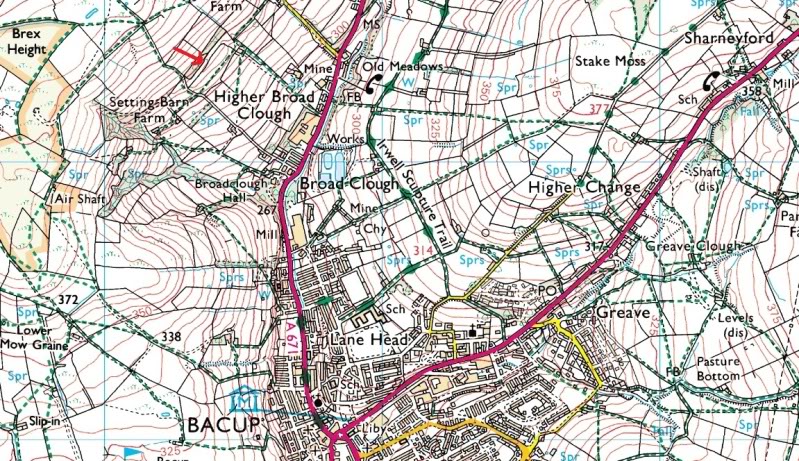 lowergate Sun Mar 25, 2012 9:41 am
lowergate Sun Mar 25, 2012 9:41 am
OSWALDTWISTLE MOOR FIELD TRIP 24/03/12
Conditions: Warm 17C, dry conditions underfoot, distant views obscured by heat haze.
START: Oswaldtwistle Mills multiple retail outlet.
Almost hidden away in this multiple retail complex is a superb local heritage centre displaying the history of Oswaldtwistle since prehistoric times. The centre was established by the local people of the town and supported by the complex owner. The section we came to view was the early pre-history illustrated ‘time line’, the sole work of local antiquarian Mr.Alan Ormerod.
Here the early archaeology of Oswaldtwistle is laid out in great detail through the medium of maps, illustrations and artefacts. Among the artefacts are three Langdale stone axes found on the Moor along with samples of birch and oak found below the blanket peat covering of the Moor. Two stone circles are recorded along with numerous possible burial mounds with locations, illustrations and diagrams. Our interest was in Thirteen Stone Hill circle, Dry Hill tumulus and the birch and oak forest below the blanket peat, the latter being slowly exposed due to erosion and slippage.
Next, up to the moor with parking available in a small lay-by on the A677 below Elm Tree Farm (SD762 251).
The farm track soon becomes a holloway/old turbury road leading over a saddle between the Moor and Thirteen Stone Hill to Haslingden Grain. Before gaining the saddle we struck off to the SW following the mediaeval boundary ditch between Oswaldtwistle and Haslingden. A mile ahead the distinct form of Dry Hill comes into view:
Until the Countryside & Rights of Way Act 2000, Oswaldtwistle Moor was private land with no public access other than two paths that crossed the moor N/S at either end. Today it is available for access on foot.
Oswaldtwistle Moor stands at c.340M ASL and is covered by a blanket peat bog some 3-4M in depth. During the 18th & 19th century’s drainage of the moor was undertaken to improve the land for sheep grazing but proved unsuccessful leaving the peat blanket formation virtually intact. Below the blanket peat lies a Neolithic/Bronze Age landscape from a time of the first forest clearances on the uplands of the Pennines that later, as the climate became cooler and wetter, led to a gradual leaching of soil nutrients, sphagnum moss and cotton grass colonized the uplands resulting in the blanket of peat bog which is so widespread today.
At the time of writing this unique landscape is about to rapidly change in a most dramatic way. For political none-economic reasons an industrial scale wind generating plant (the word ‘farm’ is inappropriate, a political whim or fancy, sounds nice and ‘environmental’, ‘green and clean’ like ‘Windowleen’) is under construction on the moor: Huge ‘Transformer’ type excavation machines are removing the peat and sub-soil covering down to the bedrock, platforms are being erected, cable conduits laid and access roads to each generating station being laid out. The result of this industrialization of the landscape will in a few years time leave the moor a denuded ‘moonscape’ as has happened on the high fells of the Bowland watershed due to industrial water extraction methods.
So we take a last look at a landscape that over the next few weeks will be gone forever.
Dry Hill (SD 748 243 is a grassy dome rising above the peat blanket to a height above 6M. Close inspection reveals it to be of stone construction built on the sub-soil below the peat. Without a doubt the tumulus is man-made and has been ascribed to the Bronze Age period on the SMR. If this is indeed a burial mound it must be the largest one ever recorded in Lancashire and must be seen as an important structure for the time. The summit of the mound commands extensive views over Blackburn and Hyndburn – the final resting place of some important person or family. Dry Hill was erected as a landscape statement and commands attention.
Taking a last look at this soon to be lost landscape we turned south and made our way over to the higher watershed reaches of Deep Clough. Rapid erosion of the peat blanket here (SD 750 239), sub-soil section seen to be about 2ft. in depth, and silver birch trees everywhere! Trees that last saw the light of day some 3500 years ago, an amazing sight. Within minutes we came upon the stump and root of a large oak tree as in a good a condition as the day it was felled, again some 3500 years ago! We intend to return this coming week to see if we can discern and record any axe marks from when it was felled.
On we went to summit of Thirteen Stone Hill where on the southern edge (SD 765
242) we found thirteen stones. Yes, thirteen large stones, but to our eyes not a thirteen stone circle. GPS location of each stone then mapping is needed to determine the nature of this feature, be it natural or man-made. Nearby we noted the evidence of systematic peat cutting in the distant past – a peat-sled Holloway passes N to S just to the W of the 13 stones. Also noted near to the stones 3 small man-made ‘ponds’, circular with raised banks – purpose unknown.
All in all a great day out for all.










